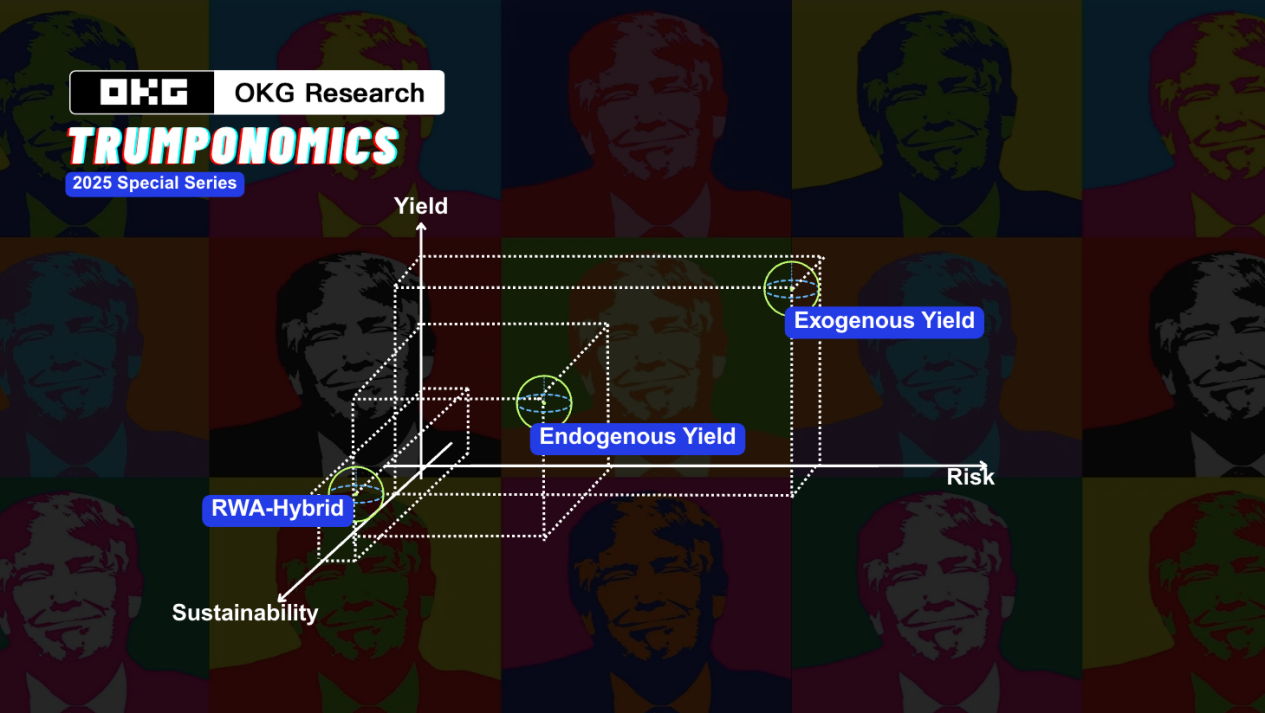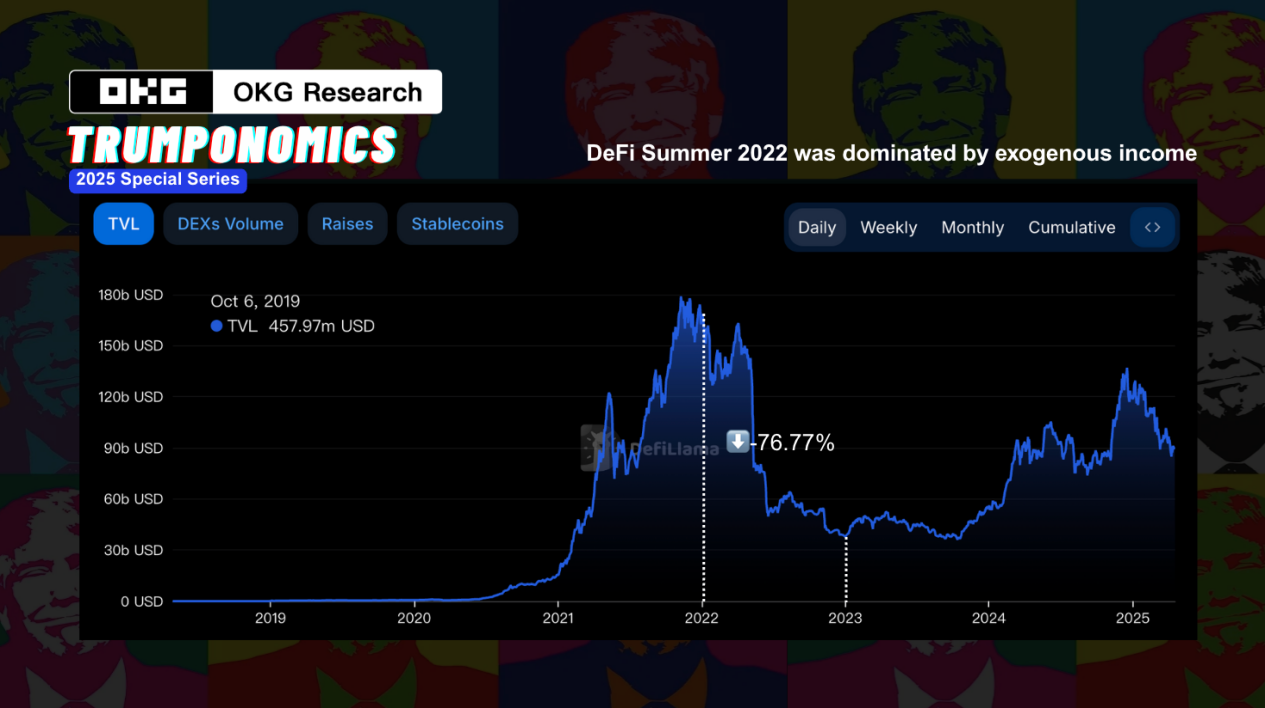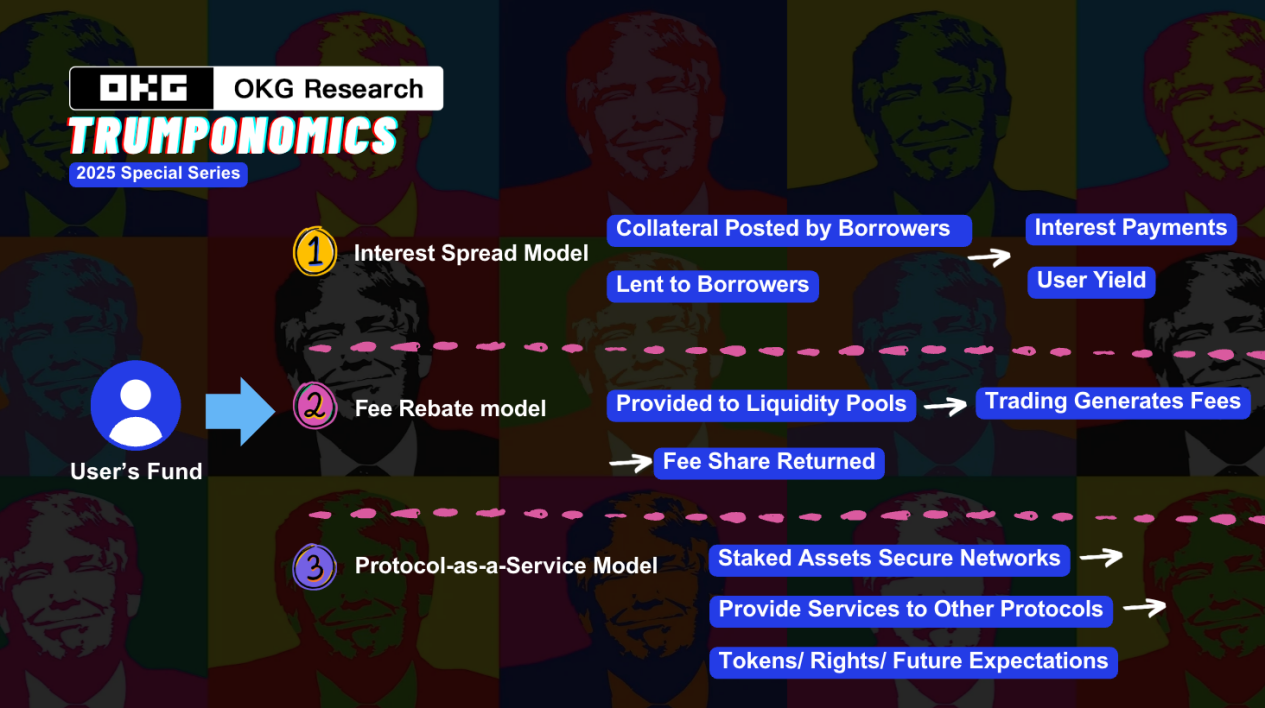Finding on-chain certainty in the crazy "Trump Economics": Analyzing three types of crypto-income assets

Reprinted from panewslab
04/22/2025·28DText/Hedy Bi, OKG Research
When tariffs became American dramas, "no new plots were released today" became the news itself. From gold prices hitting new highs to Bitcoin returning above 80,000 US dollars, risk aversion is quietly recovering. The world is becoming increasingly like a temporary grass-roots team. Every news push for upward inflation expectations, escalating geopolitical frictions or intensifying trade barriers may become the fuse to ignite market sentiment.
Today, when macro uncertainty has become the norm, "certainty" is no longer a condition for granted, but a scarce asset. In an era when black swans and gray rhino coexist, investors are not only pursuing returns, but assets that can travel through volatility and have structural support. The "crypto-interest-generating assets" in the on-chain financial system may represent this new form of certainty.
These crypto assets that promise fixed or floating income financial structures are returning to investors’ horizons, becoming anchors for them to find solid returns in a volatile market. But in the crypto world, "interest" is no longer just the time value of capital; it is often the product of the joint action of agreement design and market expectations. High returns may come from real asset income, or may conceal complex incentive mechanisms or subsidy behaviors. If you want to find true "certainty" in the crypto market, investors need not only interest rate tables, but in-depth dismantling of the underlying mechanism. As the eighth chapter of the "Trump Economics" series, this article will start from interest-generating assets, analyze the true source and risk logic of crypto-generating assets, and find certainty in uncertainty.
Since the Federal Reserve started its interest rate hike cycle in 2022, the concept of "on-chain interest rates" has gradually entered the public's vision. Faced with the long-term risk-free interest rate of 4-5% in the real world, Crypto investors have begun to re-examine the sources of returns and risk structure of on-chain assets. A new narrative has quietly taken shape -Yield-bearing Crypto Assets , which attempts to build financial products that "compete with the macro interest rate environment" on the chain.
However, the sources of income from interest-bearing assets are very different. From the cash flow that "blood-making" of the agreement itself, to the illusion of returns that rely on external incentives, to the grafting and transplantation of off-chain interest rate systems, behind the different structures are completely different sustainability and risk pricing mechanisms. We can roughly divide the interest-generating assets of current decentralized applications (DApps) into three categories, namely exogenous returns, endogenous returns and real-world assets (RWA).

Exogenous benefits: subsidy-driven interest illusion
The rise of exogenous returns is a microcosm of the early rapid growth logic of DeFi development - without the demand of mature users and real realization of gold flow, the market replaced it with "incentive illusion". Just like the early shared taxi-hailing platforms exchanged subsidies for users, after Compound started "liquidity mining", SushiSwap, Balancer, Curve, Avalanche, Arbitrum and other ecosystems have also launched huge token incentives, trying to buy user attention and locked assets in the form of "investment income".
However, this type of subsidy is essentially more like a short-term operation of the capital market "pay" for growth indicators rather than a sustainable return model. It once became the standard for the cold start of the new protocol - whether it is Layer2, modular public chain, LSDfi, and SocialFi, the incentive logic is exactly the same: relying on new capital inflows or token inflation, the structure is similar to "Ponzi". The platform uses high returns to attract users to save money, and then delays cashing through complex "unlocking rules". Those annualized returns of hundreds or thousands are often just tokens "printed" out of thin air by the platform.
This is how the Terra burst in 2022 is: the ecosystem provides up to 20% annualized returns on UST stablecoin deposits through the Anchor protocol, attracting a large number of users. The income depends mainly on external subsidies (Luna Foundation Reserves and Token Rewards) rather than real income within the ecosystem.
From historical experience, once external incentives weaken, a large number of subsidized tokens will be sold, damaging user confidence, which will cause TVL and token prices to often experience a spiral decline in death. According to Dune data statistics, after the DeFi Summer boom faded in 2022, about 30% of DeFi projects' market value fell by more than 90%, which is mostly related to excessive subsidies.

If investors want to find "stable cash flow" from it, they need to be more vigilant about whether there is a real value creation mechanism behind the returns. Promising today's returns with future inflation is not a sustainable business model after all.
Endogenous benefits: redistribution of use value
Simply put, the money earned by the agreement itself is allocated to the user. It does not rely on issuing coins to attract people, nor does it rely on subsidies or external blood transfusions, but rather income naturally generated through real business activities, such as lending interest, transaction fees, and even fines in liquidation of defaults. These incomes are somewhat similar to the "dividends" in traditional finance, so they are also called "dividend-like" encrypted cash flow.
The biggest feature of this type of profit is its closed-loop and sustainability : the logic of making money is clear and the structure is healthier. As long as the agreement is operating and users are using it, there will be income coming in, and there is no need to rely on market hot money or inflation incentives to maintain operation.
So we can more accurately judge how certain its returns are. We can divide this type of income into three prototypes:
The first category is the "borrowing and interest rate spread type". This is the most common and easy-to-understand pattern in the early days of DeFi. Users deposit funds into loan agreements such as Aave, Compound, etc., and the agreement matches the borrower and lender, and the agreement earns interest spreads from it. Its essence is similar to the traditional bank's "deposit and loan" model - the interest in the fund pool is paid by the borrower, and the lender obtains part of it as income. This type of mechanism structure is transparent and efficient, but its return level is closely related to market sentiment. When overall risk appetite declines or market liquidity shrinks, interest rates and returns will also decline.
The second category is "handling fee refund type". This type of income mechanism is closer to the income sharing structure in which shareholders participate in profit dividends in traditional companies, or the income sharing structure in which specific partners obtain returns based on revenue ratios. In this framework, the agreement returns part of the operating income (such as transaction fees) to participants who provide resource support, such as liquidity providers (LPs) or token stakers.
Taking the decentralized exchange Uniswap as an example, the agreement will allocate part of the handling fees generated by the exchange to users who provide liquidity to them in proportion. In 2024, Aave V3 provides an annualized return of 5%-8% for the stablecoin liquidity pool on the Ethereum main network, while AAVE stakeholders can earn more than 10% annualized returns in certain periods. These incomes are entirely derived from economic activities endogenous to the agreement, such as lending interest and handling fees, and do not rely on external subsidies.
Compared with the "borrow and interest rate spread type", a mechanism closer to the bank model, the "fee refund type" returns are highly dependent on the market activity of the agreement itself. In other words, its returns are directly linked to the volume of the agreement business - the more transactions, the higher the dividends, and when the transactions are reduced, revenue fluctuates accordingly. Therefore, its stability and anti-cyclical risk ability are often not as stable as the lending model.
The third category is "protocol service-oriented" income. This is the most structurally innovative type of endogenous income in crypto finance, and its logic is close to the model in which infrastructure service providers provide key services to customers and charge fees in traditional business.
Taking EigenLayer as an example, the protocol provides security support for other systems through the "re-staking" mechanism and receives rewards. This type of income does not rely on loan interest or transaction fees, but comes from market-oriented pricing of the service capabilities of the agreement itself. It reflects the market value of on-chain infrastructure as a "public goods". This type of return is more diverse, which may include token points, governance rights, and even expected returns that have not yet been fulfilled in the future, showing strong structural innovation and long-term nature.
In traditional industries, it can be compared to cloud service providers (such as AWS) providing computing and security services to enterprises and charging fees , or financial infrastructure institutions (such as custody, clearing, and rating companies) providing trust guarantees for the system and obtaining income . Although these services do not directly participate in terminal transactions, they are indispensable underlying support for the entire system.

**Real interest rates on the chain: the rise of RWA and interest-bearing
stablecoins**
At present, more and more capital in the market is beginning to pursue a more stable and predictable return mechanism: on-chain assets anchor real-world interest rates. The core of this logic is: connecting on-chain stablecoins or crypto assets to off-chain low-risk financial instruments, such as short-term treasury bonds, money market funds or institutional credit, so as to obtain "deterministic interest rates in the traditional financial world" while maintaining the flexibility of crypto assets. Representative projects include MakerDAO's configuration of T-Bills, OUSG launched by Ondo Finance (connected to BlackRock ETF), Matrixdock's SBTB, and Franklin Templeton's tokenized money market fund FOBXX. These agreements attempt to "import the Fed's benchmark interest rate onto the chain" as a basic income structure. This means
At the same time, interest-bearing stablecoins, as a derivative form of RWA, have also begun to move towards the forefront. Unlike traditional stablecoins, this type of asset does not passively anchor the US dollar, but actively embed off-chain income into the token itself. Typical examples are the USDM of Mountain Protocol and the USDY of Ondo Finance, and the daily interest rate and source of income are short-term government bonds. By investing in US Treasury bonds and USDY provides users with stable returns, with a yield of nearly 4%, which is 0.5% higher than traditional savings accounts.

They try to reshape the logic of using “digital dollars” to make it more like an “interest account” on a chain.
Under the influence of RWA, RWA+PayFi is also a scenario worthy of attention in the future: directly embed stable income assets into payment tools, thus breaking the binary division between "assets" and "liquidity". On the one hand, users can enjoy interest-bearing income while holding cryptocurrencies. On the other hand, payment scenarios do not require sacrificing capital efficiency. Products like the USDC automatic income account on Base L2 launched by Coinbase (similar to "USDC as a checking account") not only increase the attractiveness of cryptocurrencies in actual transactions, but also open up new usage scenarios for stablecoins - converting from "dollars in the account" to "capital in the living water".
Three indicators for finding sustainable interest-generating assets
The logical evolution of encryption "interest-generating assets" actually reflects the process of the market gradually returning to rationality and redefining "sustainable returns". From the initial high inflation incentives and token subsidies to the governance of tokens, more and more agreements now emphasize their own hematopoietic capabilities and even the income curve of the off-chain, structural design is moving out of the extensive stage of "intra-rolling money-making" and moving to more transparent and refined risk pricing. Especially at a time when macro interest rates remain high, if the encryption system wants to participate in global capital competition, it must build a stronger "return rationality" and "liquidity matching logic". For investors seeking solid returns, the following three indicators can effectively judge the sustainability of interest-generating assets:
- Is the source of income "endogenous" sustainable?
For truly competitive interest-generating assets, the income should come from the agreement's own business, such as lending interest, transaction fees, etc. If the return mainly depends on short-term subsidies and incentives, it is like "passing flowers by beating the drum": the subsidies are still there, the income is still there; once the subsidies are stopped, the funds will leave. Once this short-term "subsidy" behavior becomes a long-term incentive, it will exhaust project funds and easily enter the death double helix of TVL and currency prices.
- Is the structure transparent?
Trust on the chain comes from openness and transparency. When investors leave the familiar investment environment, that is, traditional financial fields endorsed by banks and other intermediaries, how should they be judged? Is the flow of funds on the chain clear? Is the interest allocation verifiable? Is there a risk of centralized custody? If these problems are not figured out, they will be black box operations, exposing the system to its vulnerability. The mechanism with clear structure of financial products and open and traceable on-chain is the real underlying guarantee.
- Are the benefits worthy of the actual opportunity cost?
Against the backdrop of the Federal Reserve maintaining high interest rates, if the returns of on-chain products are lower than Treasury bond yields, it will undoubtedly be difficult to attract rational funds. If on-chain returns can be anchored to realistic benchmarks like T-Bill, it will not only be more stable, but may also become a "interest rate reference" on-chain.
However, even "interest-generating assets" are never truly risk-free assets. No matter how stable their income structure is, we still need to be wary of the technical, compliance and liquidity hidden dangers in the on-chain structure. From whether the liquidation logic is sufficient, to whether the protocol governance is centralized, to whether the asset custody arrangements behind RWA are transparent and traceable, these all determine whether the so-called "deterministic returns" have real cashability. Not only that, the market for interest-generating assets in the future may be a reconstruction of the on-chain "money market structure" . In traditional finance, the money market assumes the core function of capital pricing with its interest rate anchoring mechanism. Now, the world on-chain is gradually establishing its own concepts of "interest rate benchmark" and "risk-free returns", and a more profound financial order is being generated.


 jinse
jinse
